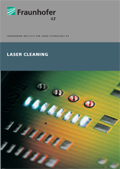Cleaning and removal can be applied to a wide range of combinations between surface layers and base materials. The technique can be used for large-scale cleaning as well as for cleaning locally well defined geometries down to the micro range.
If high cleaning rates are required, high-power Nd:YAG and CO2 lasers (in the kW range) are used. Examples of these applications include the removal of carbon-black-filled elastomer layers from a colored elastomer base material, the cleaning of printing screens and the removal of epoxy coating powder layers from conductor rails. With laser power in the kW range, typical cleaning rates for layer thicknesses of several 100 µm reach several cm2/s.
Examples of mobile applications include cleaning tools in assembled, hot condition and cleaning old weather-worn steel constructions (e.g. bridges, high-voltage pylons, large tanks and ships) before applying new corrosion-prevention coatings. The work is carried out with specially developed manually guided processing heads. Further mobile applications include cleaning airplanes and high-speed cleaning of rail heads, for which fiber-coupled laser sources working in pulsed mode with pulse durations of about 100 ns and average output powers of up to 1500 W are used.
Other applications include the removal of oil and grease as a pre-treatment before joining processes (e.g. welding, soldering and adhesive bonding), the descaling of metal sheets and the cleaning of printing rolls.
In the micro range the technique is used for the structured removal of lacquer layers before selective electroplating and oxide removal from copper as preparation for tin coating. Experience with laser cleaning in combination with new developments of laser sources and suitable system technology shows that high growth potential exists for this promising cleaning technique.

 Fraunhofer Institute for Laser Technology ILT
Fraunhofer Institute for Laser Technology ILT